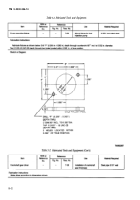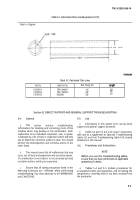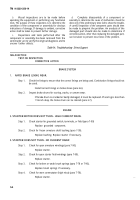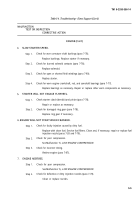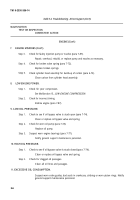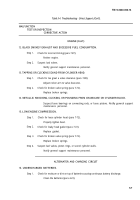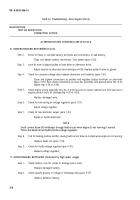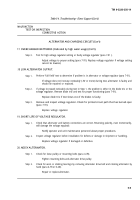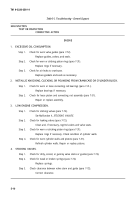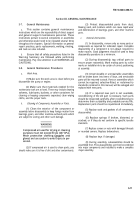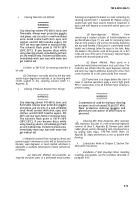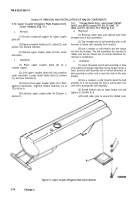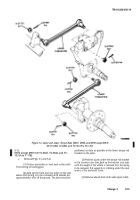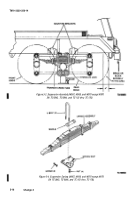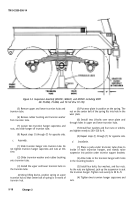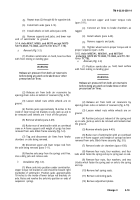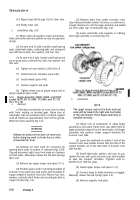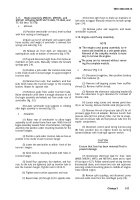TM-9-2330-356-14
SEMITRAILER, TANK: 5000 GALLON, BULK HAUL, SELF LOAD/UNLOAD M967 AND M967A1; SEMITRAILER, TANK: 5000 GALLON, FUEL DISPENSING, AUTOMOTIVE M969 AND M969A1; SEMITRAILER, TANK: 5000 GALLON, FUEL DISPENSING, UNDER/OVERWING AIRCRAFT M970 AND M970A1
TECHNICAL MANUAL; OPERATOR’S, UNIT, DIRECT SUPPORT, AND GENERAL SUPPORT MAINTENANCE MANUAL
OCTOBER 1990
TM-9-2330-356-14 - Page 320 of 528
TM 9-2330-356-14
d.
Care of Bearings.
WARNING
Dry cleaning solvent P-D-680 is toxic and
flammable.
Always
wear protective
goggles and gloves, and use only in a well-
ventllated area. Avoid contact with skin,
eyes, and clothes, and DO NOT breathe va-
pors. DO NOT use near open flame or ex-
cessive heat. The solvent’s flash point Is
1OO°F-138°F (38°C-59°C). If you be-
come dizzy while using cleaning solvent,
Immediately get fresh air and medical help.
If solvent contacts eyes, immediately wash
your eyes with water and get medical aid.
Compressed air used for drying or clean-
ing purposes must not exceed 30 psi
(207 kPa).
Wear protective clothing
(goggles and gloves) and use caution to
avoid Injury to personnel.
NOTE
Refer to TM 9-214 for further Information on
the inspection, care, and maintenance of
bearings.
(1) Clean ball and roller bearings by placing them
in a wire basket and immersing in a container of fresh dry
cleaning solvent (item 11, Appendix E). Agitate the
bearings in the solvent to remove all traces of old
lubricant.
(2) After cleaning the bearings, dry them with
clean compressed air. Take care to prevent spinning the
bearings when using a compressed air jet.
(3) Dip the cleaned bearings in clean engine oil
and immediately wrap them in a lint-free cloth (item 24,
Appendix E) to protect them from dust and other foreign
matter.
5-9.
Specific Procedures
a.
Welding.
(1) Refer to TM 9-237 for welding instructions
and materials. All welds must reflect good workmanship
and approved welding procedures. Welds must be secure,
free from cracks, excessive spatter, and obvious defects.
(2)
Read and observe all safety precautions in the
Warning Summary before performing any welding
operation.
b.
Surface Protection.
(1) Clean and repaint all surfaces on which paint
has deteriorated or become damaged.
(2) Do not paint grounding studs or electrical
harnesses or leads.
(3) Paint exterior of vehicle olive drab in
accordance with TT-E-529 or TT-E-485.
c.
Repairing Damaged Threads.
(1) When determined feasible by inspection,
damaged threads should be repaired by retapping, by use
of a thread die or a thread restorer file.
(2) Tapped holes for screw thread inserts that
have mutilated threads may be repaired by:
(a)
Drilling and tapping holes oversize, then
installing larger screws.
(b)
Filling tapped hole by welding, then
redrilling and tapping hole to original size.
d.
Removing Burrs, Scratches, and Raised Metal.
WARNING
Dry cleaning solvent P-D-680 Is toxic and
flammable. Always wear protective goggles
and gloves, and use only In a well-ventilated
area. Avoid contact with skin, eyes, and
clothes, and DO NOT breathe vapors. DO
NOT use near open flame or excessive heat.
The solvent’s flash point is 100°F-138°F
(38°C-59°C). If you become dizzy while us-
ing cleaning solvent, immediately get fresh
air and medical help. If solvent contacts eyes,
immediately wash your eyes with water and
get medical aid.
(1) Use fine mill file, soft stone, or crocus cloth
(item 4, Appendix E) dipped in dry cleaning solvent
(item 11, Appendix E) to remove burrs, scratches, or
raised metal.
(2) When filing aluminum, clean file often with
steel file brush to avoid loading file with aluminum
particles which will gouge work surface.
5-12
Back to Top

